Tron: Legacy
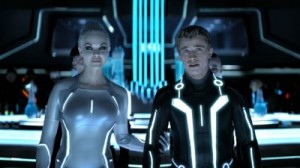 My first memory of seeing a movie in the theater was when I was 4 years old. The movie was Steven Lisberger’s Tron and though I can’t recall my initial reaction to the film, I’d assume that I enjoyed it, seeing as that’s the level the movie is pitched at. I didn’t see the movie again until college, on a grainy, cropped VHS, and it went beyond the feeling of nostalgia, almost to the point of legitimate entertainment. Don’t get me wrong, the movie was still corny and the effects amusingly antiquated, but the constant panning and scanning of the image lent the film a real feeling of watching a primitive video game.
My first memory of seeing a movie in the theater was when I was 4 years old. The movie was Steven Lisberger’s Tron and though I can’t recall my initial reaction to the film, I’d assume that I enjoyed it, seeing as that’s the level the movie is pitched at. I didn’t see the movie again until college, on a grainy, cropped VHS, and it went beyond the feeling of nostalgia, almost to the point of legitimate entertainment. Don’t get me wrong, the movie was still corny and the effects amusingly antiquated, but the constant panning and scanning of the image lent the film a real feeling of watching a primitive video game.
When I saw Tron on DVD, cleaned up and in widescreen, it looked wrong. The format was simply too good for the movie, as the limitations of VHS had worked along with the limitations of the film. Every awkward bit of dialogue that was sort of charming on tape, clunked when presented with crystal clear audio.
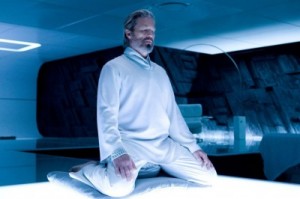 Such a reaction tempered any excitement I had for a sequel to Tron, Joseph Kosinski’s Tron: Legacy. How could a sequel benefit from hype and enormous amounts of money ($200 million) thrown at the movie and especially the marketing? Not to mention that it was to be shown in 3D, a format currently in vogue, but death to the consistency of image quality. The darkening of the look of the film caused by the 3D could only hurt what might generously be considered a very expensive planetarium laser light show. In the original film, the sequences inside the video game that bitter and betrayed computer programmer Kevin Flynn is sucked into (and fights against the very programs he designed), were shot in black and white and the colored uniforms were added in post-production. It gave the film an eerie, otherworldly quality, like the color was fighting a losing battle against a black and white world (a fitting metaphor for the simplicity of the screenplay, and a precursor to Pleasantville).
Such a reaction tempered any excitement I had for a sequel to Tron, Joseph Kosinski’s Tron: Legacy. How could a sequel benefit from hype and enormous amounts of money ($200 million) thrown at the movie and especially the marketing? Not to mention that it was to be shown in 3D, a format currently in vogue, but death to the consistency of image quality. The darkening of the look of the film caused by the 3D could only hurt what might generously be considered a very expensive planetarium laser light show. In the original film, the sequences inside the video game that bitter and betrayed computer programmer Kevin Flynn is sucked into (and fights against the very programs he designed), were shot in black and white and the colored uniforms were added in post-production. It gave the film an eerie, otherworldly quality, like the color was fighting a losing battle against a black and white world (a fitting metaphor for the simplicity of the screenplay, and a precursor to Pleasantville).
In Kosinski’s film, that subtext is missing, because technology has caught up to the original ideas and the black and white is no longer necessary as the entire film can be created on a computer combined with green screen footage. Kosinski, making his feature debut, was probably so excited about getting the opportunity to attach his name to something he enjoyed as a kid, he forgot that the original film is infantile, a show-off for early CGI, and that trying to take infantilism seriously is a major mistake.
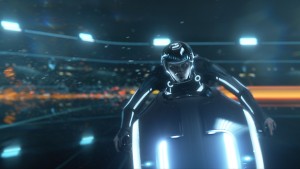 Tron: Legacy is so concerned with filling in backstory that the opening narration is combined with several different levels of exposition, from TV imagery that fills in the blanks, flashbacks, news reports, board meetings, that the entire opening act is a throwaway for anyone familiar with the first film. Simply, Flynn had a son, and when the kid, Sam, was still in grade school, he disappeared, leaving the corporation he built behind to be taken away by vultures who only want to exploit the public with its computer software.
Tron: Legacy is so concerned with filling in backstory that the opening narration is combined with several different levels of exposition, from TV imagery that fills in the blanks, flashbacks, news reports, board meetings, that the entire opening act is a throwaway for anyone familiar with the first film. Simply, Flynn had a son, and when the kid, Sam, was still in grade school, he disappeared, leaving the corporation he built behind to be taken away by vultures who only want to exploit the public with its computer software.
The rest of the information, that Sam misses his dad and every year tries to sabotage what’s become of his company*, could have been implied without giving us all the specifics, and then repeating it for ½ an hour. The first section is absolutely deadly to a viewer, it has an ugly brown look to it, Sam, played by Garrett Hedlund and looks like Christian Finnegan by way of Sam Worthington, is irritating, and the cartoon villains trying to hi-jack Flynn’s company don’t really rise to the level of hateable, just kind of sniveling and smug. Hedlund is done no favors by the dialogue, he’s an “extreme” guy, seemingly written in the late ‘90s as he does his outrageous stunts like parachuting off of tall buildings and saying, “now that’s what I’m talkin’ about!”
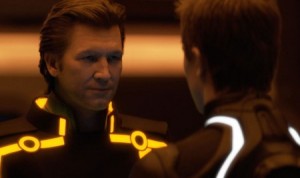 Of course, Sam is going to learn the lessons of humility and love (in the real world, he’s just a poor little rich kid) from his father once he enters “the grid” of the video game that his dad has been stuck in for the last 20 years. But he mostly behaves like a temperamental monkey, exacerbated by the imagery provided wherein faceless henchmen attack our heroes with the aid of what looks like digital flying monkeys borrowed from the set of The Wizard of Oz.
Of course, Sam is going to learn the lessons of humility and love (in the real world, he’s just a poor little rich kid) from his father once he enters “the grid” of the video game that his dad has been stuck in for the last 20 years. But he mostly behaves like a temperamental monkey, exacerbated by the imagery provided wherein faceless henchmen attack our heroes with the aid of what looks like digital flying monkeys borrowed from the set of The Wizard of Oz.
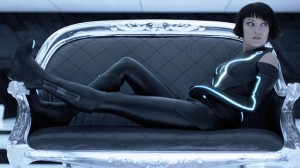 Kosinski had to have been aware of all of the parallels, the visuals of this particular video game world are clearly inspired by Blade Runner, certain images recall Flash Gordon, and of course the original film’s reliance on Star Wars as a point of reference is driven into the ground here. When Bridges, aged and bearded, shows up to battle under a black hood hiding his face, along with his surfer dialogue, he probably should have just been renamed Obi Wan Lebowski. Even Daft Punk’s pounding score, so loud and dominating that you could feel the floor vibrating in the IMAX theater, is a melding of the scores from Blade Runner and The Terminator**. The score is relentlessly enthusiastic and moody, and promises a much better movie than Kosinski is able to deliver, especially as Tron: Legacy limps through more and more confusing exposition during Sam and Kevin’s reunion. These scenes could have used a lot of clean-up, it’s why this sequel is more than two hours long and never sustains any momentum for more than a few minutes.
Kosinski had to have been aware of all of the parallels, the visuals of this particular video game world are clearly inspired by Blade Runner, certain images recall Flash Gordon, and of course the original film’s reliance on Star Wars as a point of reference is driven into the ground here. When Bridges, aged and bearded, shows up to battle under a black hood hiding his face, along with his surfer dialogue, he probably should have just been renamed Obi Wan Lebowski. Even Daft Punk’s pounding score, so loud and dominating that you could feel the floor vibrating in the IMAX theater, is a melding of the scores from Blade Runner and The Terminator**. The score is relentlessly enthusiastic and moody, and promises a much better movie than Kosinski is able to deliver, especially as Tron: Legacy limps through more and more confusing exposition during Sam and Kevin’s reunion. These scenes could have used a lot of clean-up, it’s why this sequel is more than two hours long and never sustains any momentum for more than a few minutes.
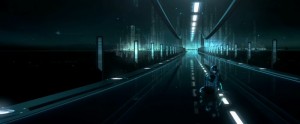 It’s only in the mostly wordless third act, an elaborate escape attempt by the Flynns and a program named Quorra (played by the unforgettably high-cheekboned Olivia Wilde*** whose role is used for stem cell research advocacy), where the visuals take over and the newfangled vehicles, including what looks like a stingray spaceship, remind us what the movie should have been. The 3D is not special, there are a few shots here and there (including those featured in the trailer where the “lightcycles” fly over the camera) that are impressive, but not enough to justify the squinting and glasses adjustments that a viewer has to go through. And the choice to de-age Bridges to his younger self to also play the villainous Clu was disastrous. The effects are good enough to slightly resemble the young Bridges, but not good enough to fully accept the creepy Polar Express-style animation, especially in the way the lips move when Clu talks (which look like video game cut scenes). The CGI either needed to be perfect, or so bad that the scenes become campy that you forgive the chintziness, the almost we get doesn’t work.
It’s only in the mostly wordless third act, an elaborate escape attempt by the Flynns and a program named Quorra (played by the unforgettably high-cheekboned Olivia Wilde*** whose role is used for stem cell research advocacy), where the visuals take over and the newfangled vehicles, including what looks like a stingray spaceship, remind us what the movie should have been. The 3D is not special, there are a few shots here and there (including those featured in the trailer where the “lightcycles” fly over the camera) that are impressive, but not enough to justify the squinting and glasses adjustments that a viewer has to go through. And the choice to de-age Bridges to his younger self to also play the villainous Clu was disastrous. The effects are good enough to slightly resemble the young Bridges, but not good enough to fully accept the creepy Polar Express-style animation, especially in the way the lips move when Clu talks (which look like video game cut scenes). The CGI either needed to be perfect, or so bad that the scenes become campy that you forgive the chintziness, the almost we get doesn’t work.
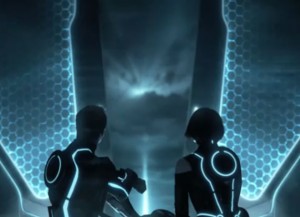 That’s really where the finances hurt the film, if something is big, you’re going to notice the eyesore moments even moreso, and it’s another reason why treating infantilism like gospel is so problematic. The scale of Tron: Legacy turns the famed lightcycle and Frisbee/boomerang Coliseum-esque showdowns into completely forgettable scenes, we don’t get much chance to orient ourselves before it’s time to move on to the next stunt or plot point. Tron: Legacy has a “hurry up and wait” feel to it, the elder Bridges is trying to just wait his existence out so Clu can’t take advantage of his energy, and the characters mostly sit around explaining what’s going on to each other and us.
That’s really where the finances hurt the film, if something is big, you’re going to notice the eyesore moments even moreso, and it’s another reason why treating infantilism like gospel is so problematic. The scale of Tron: Legacy turns the famed lightcycle and Frisbee/boomerang Coliseum-esque showdowns into completely forgettable scenes, we don’t get much chance to orient ourselves before it’s time to move on to the next stunt or plot point. Tron: Legacy has a “hurry up and wait” feel to it, the elder Bridges is trying to just wait his existence out so Clu can’t take advantage of his energy, and the characters mostly sit around explaining what’s going on to each other and us.
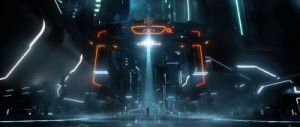 There aren’t characters here, it’s all bloodless and functional, so when Michael Sheen throws in a truly campy performance as Zeus, who runs a high end dance club for programs, it’s a relief, because he brings energy to the role, even if, outside of the context of the movie, he’s pretty embarrassing. He’s a perfect representation of what Tron: Legacy should have been, energetic and silly, but embarrassing if you’re in the wrong mood. I’m afraid they only got the second part right.
There aren’t characters here, it’s all bloodless and functional, so when Michael Sheen throws in a truly campy performance as Zeus, who runs a high end dance club for programs, it’s a relief, because he brings energy to the role, even if, outside of the context of the movie, he’s pretty embarrassing. He’s a perfect representation of what Tron: Legacy should have been, energetic and silly, but embarrassing if you’re in the wrong mood. I’m afraid they only got the second part right.
* The inherent message being sent by Sam’s actions is that the software Flynn’s company is selling should be open source and free for all, and the board wants to profit by selling the same products every year that are updates only in the sense that the box art has changed. Did the Tron: Legacy producers and the distributor Disney not realize the message here? That Sam, the hero, and later Kevin, are advocating piracy of all types, especially when the manufacturers are only offering souped-up versions of previous software, you know, like a bloated and unnecessary sequel?
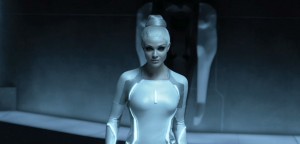 ** Tron: Legacy has a very odd similarity to Terminator 2, in that they both open with unruly orphans breaking into secure machines with cobbled together computer code breakers, an ATM in T2, a high rise building’s massive bank-vault-style door in Tron: Legacy.
** Tron: Legacy has a very odd similarity to Terminator 2, in that they both open with unruly orphans breaking into secure machines with cobbled together computer code breakers, an ATM in T2, a high rise building’s massive bank-vault-style door in Tron: Legacy.
*** Unfortunately, she’s buried beneath a butch-goth haircut.



